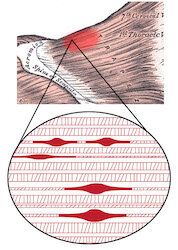A major contributor of myofascial pain is the presence trigger points. Trigger points can be incredibly painful and stubborn to release. They refer pain to other areas of the body, mimic conditions including sciatica, and can cause tension headaches and TMJ, along with many other chronic conditions.
Myofascial pain syndrome affects up to 85% of the general population causing considerable grief; it is therefore surprising that trigger points are still very much a mystery in the scientific world. Professions including myotherapy and osteopathy are leaders in treating trigger points, utilising their skills in dry needling and ischemic trigger point release to provide much sought after pain relief.
What are trigger points?
Trigger points can be described as the ‘knots’ you feel within the muscles. They are taut, contracted bands that usually reside at the attachment ends of the muscles, where the muscle meets the tendon.
The research into trigger points indicates they are formed due to an influx of a substance called Acetylcholine which is transmitted from the nerve to the muscle via an endplate. This normally happens due to continued overuse of the muscle.
The high levels of Acetylcholine cause excessive contraction and spasm within the muscle. The contractions cause blood vessels that supply the muscle to constrict, limiting its blood supply. This leads to alogenic (pain inducing) substances being released.
The alogenic substances attach to the nerve endings found in the muscle, causing further inflammation of the nerves. Once these peripheral nerve endings are switched on, the body receives pain messages in the affected muscle. This is the pain we feel, it is called peripheral sensitisation as it is only felt on the periphery, or a localised area. Peripheral sensitistion can be treated successfully by trigger point therapy (dry needling, ischemic trigger point therapy, heat, stretch).
Trigger Point in the Upper Trapezius muscle
Image reference: David G. Simons, Janet G. Travell, Lois S. Simons. Myofascial Pain and Dysfunction: The Trigger Point Manual
How does the pain refer to other areas?
There is a second, more debilitating stage called central sensitisation. This second process causes pain to refer to other areas of the body, due to an overload of pain messages within the untreated muscle. The influx of pain messages travel onwards to the spinal cord. The spinal cord proceeds to send these messages to the brain, causing a perceived spread of pain throughout the body; the initial localised pain now becomes chronic and difficult to treat.
Where are Trigger Points found?
Trigger points are generally found in the postural muscles, the muscles we use to hold our body in position when sitting, lying and standing. They are also found in smaller muscles responsible for repetitive movements such as typing or playing an instrument. Trigger points do not affect the big powerful muscles to the same extent; these include muscles we use for strong, dynamic movements including lifting, jumping etc.
Weakened muscles are more susceptible to trigger points, these muscles receive less blood flow and therefore become less elastic. This reduced elasticity can be perceived as the stiffness or tightness an individual feels.
Part 2 of this article will look at the current treatment for trigger points and how the treatment works.


